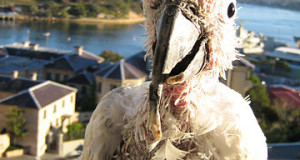Oxford University researchers played recorded calls of antbird pairs to other pairs resident in a specific territory. The resident pair responded as expected – male and female sang together in a vigorous display of unity, showing their willingness to defend their home.
Reaction to a Single Female
However, when the song of an unattached female antbird was played, the situation changed dramatically. The resident male responded with a mating call – in essence “flirting” with the new female. Amazingly, his mate began singing loudly over his song, in an apparent attempt to “jam” the notes and render him less attractive to the interloping female!
Not to be outdone, the would-be Romeo then began altering his call in an effort to avoid the interfering song of his mate!
Female Inca Terns Tolerate No Nonsense!
Research is now being conducted to determine if other birds act in a similar fashion…I’m betting that many do. The Inca terns (Larosterna inca) pictured here are part of a flock of 30 that I cared for in a huge outdoor exhibit at the Bronx Zoo. I noticed a great deal of interaction during the breeding season, with single females vying for the attentions of males that were already paired and in possession of desirable nesting cavities.
Female terns are, however, a bit more “assertive” than their antbird cousins – a few sharp pecks to the male’s head generally put a quick end to any thoughts of “wandering”!
Further Reading
Antbirds are quite beautiful and interesting. The common name arises from their unique mode of hunting. By following hoards of foraging army ants, they are able to capture many fleeing insects that would otherwise be difficult to locate in the underbrush.
I was fortunate enough to observe this spectacle in a Costa Rican rainforest – it is a “must see” for birders, I assure you! You can read more about antbirds and see photos of many species at http://www.arthurgrosset.com/sabirds/warblingantbird.html.
 That Bird Blog – Bird Care and History for Pet Birds
That Bird Blog – Bird Care and History for Pet Birds



